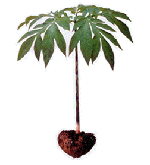|
Konjac glucomannan (KGM) Property
Konjac complex powder
Hydrocolloids
Reference
    
KGM is water-soluble dietary fiber and can be
used as a gelling agent, thickener, stabilizer, emulsifier and
film former.
1. Water
solubility:
KGM is readily dissolved in water and it can absorb 100-fold as
much as water in volume. Its water solution is a pseudo-plastic
liquid, characterized by shear thinning. One
particle of konjac powder consists of extremely long thread-like
macromolecules tangled together. When it comes in contact with
water, water molecules enter and are absorbed into the chain,
gradually causing the particle to swell to about 200 times as
its original volume, and turning the konjac powder into viscous
liquid.
2.
Thickener:
KGM has the highest molecular weight and strongest viscosity among
any dietary fiber known to science, and has extremely high density.
The unmodified naturally acetylated konjac glucomannan
produce highly viscous solutions. Typically, 1% in water of commercially
available konjac products has viscosities from at least 20.000cP
to more than 40.000cP when measured at 30 oC, the highest
than any other natural thickening agents.
KGM interacts synergistically with carrageenan, xanthan gum, locust
bean gum (LBG) and starch. For example, the addition of 0.02-0.03%
crude KGM to 1% xanthan gum will raise its viscosity by 2-3 times
under heating. Konjac-xanthan gels are cohesive and extremely
elastic in nature. Max. gel strength is seen at a ratio of konjac
and xanthan between 1:2,5 to 1: 4.
The konjac-carrageenan interaction is similar to that of LBG-carrageenan
apart from the konjac-carrageenan interaction being much stronger.
Konjac interacts with most starches to produce a remarkable increase
in viscosity allowing for an optimization of starch-rich formulations,
whether the purpose is a reduction of calories or improvement
of texture.
3.
Stabilizer:
Unlike xanthan gum, guar gum or locust bean gum, konjac gum is
the non-ionic type and therefore little influenced by the salt
in the system. At ambient temperature, konjac gum remains stable
without precipitation even if the pH drops to a level below 3.3.
When konjac gum is used instead of locust bean gum as the stabilizer
and added to ice cream, cheese and other dairy products, it will
stabilize their quality by preventing the development of ice crystals.
4.
Gelling Agent:
As a gelling agent, KGM is quite unique for its ability to form
thermo-reversible and thermo- irreversible gels under different
conditions.
In food industry, many kinds of products rely on the Gelling property
of hydrophilic colloids to form their special shape or structure
and to guarantee their timely thaw at a certain temperature. Carrageenan
gum, pectin, gelatin and sodium alginate fall into this category.
Xanthan gum does not gelatinize when used alone, but it can form
gel at any pH when used in combination with konjac gum. At a pH
of 5, the two gums show a greatest synergistic effect and when
xanthan gum is used with konjac gum at a ratio of 3:2, the greatest
gelatification will be achieved. This gelatification of the compound
gum behaves as heat reversible: it appears in the solid state
under indoor temperature only if it is no higher than 40℃., it will be in a semi-solid or
liquid state at 50℃ or above. When the temperature drops back to the ambient temperature,
it will resume the solid state. Base on this property of the compound
gum, various types of jelly, budding, jam and fat-free confectioneries
can be made by adopting different concentrations of the compound
gum and adjusting to different pH values.
KGM is composed of a repeating polysaccharide chain. With addition
of a mild alkali such as calcium hydroxide, Konjac gel will set
to a strong, elastic gel resisting melting even under extended
heating conditions.
KGM solution does not form gel because its acetyl group prevents
the long chains of glucomannan from approaching each other, However,
it does form gel when heated at a pH of 9-10. This gel behaves
stable to heat and it will remain stable under repeated heating
at 100℃ or even
at 200℃. In slight alkaline environment,
konjac solution forms thermo-irreversible gel after cooling from
hot solution. That is why this gel is called non-reversible gel,
whose mechanism is that the acetyl deviates from glucomannan in
a naked state when heated under an alkali condition and partial
structural crystallization occurs due to the formation of hydrogen
bonds between molecules. And KGM becomes stable due to the formation
of a net-like structure with the crystals as nodes. Making use of the heat non-reversible property
of the konjac gum, it has been widely used to make a great variety
of foods, such as konjac cake, konjac chips, konjac slices, konjac
noodles, and also imitating foods for vegetarians.
5.
Film
Former:
Konjac is a powerful film former - both alone and in combinations
with other gums such as carrageenan.
6.
Soluble Dietary Fiber Source:
The fresh konjac contains
an average of 13% dry matter, 64% of the dry matter is glucomannan:
30% is starch.
|
|